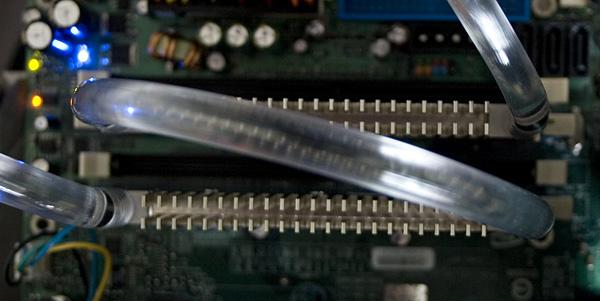OCZ Flex XLC Water-Cooled CAS-3 DDR2-800 2GB Memory Kit
Water Cooling

We used 3/8 outside diameter - 1/4" inner diameter tubing for our tests, which were connected to a dedicated water cooling system. Other water blocks were taken out of the loop, although in most real world scenarios, the water-cooling system would be used to also cool the CPU and GPU along with the memory modules.
We wish OCZ would have included some sort of clamping system for when the tube is attached. Even though our tubing created a tight seal around the barb, it would be nice to have an additional protection method with water flowing next to expensive memory modules. For safety's sake, adding a small zip-tie helped our peace of mind. We did not experience any leaks with the OCZ memory kit, even without additional security measures in place.

|

|
The modules are designed in such a way that they will not impede on the space of the module slot next to them. As you can see, water flows into the primary module, which is connected via a short tube to the next module, which flows water back out to the cooling system. You could certainly purchase two of these kits (four modules total) and water-cool all of them. It would likely look quite impressive, as well.

For thermal testing, we used an infrared probe to measure the external heatsink temperature, PCB temperature of the memory module, and the PCB temperature of the surrounding motherboard. We wanted to see if the water cooling system helped to extract heat from the module itself, along with how this affected the overall motherboard temperatures.



As you can see, adding water cooling to the mix helps temperatures all around. With our water cooling system active, the memory modules were actually cool to the touch during intensive benchmarking and stress testing. Without the water cooling , the modules were warm (but not hot) to the touch. While the water cooling system is quite simplistic, it's also highly effective at removing heat generated by the memory.






